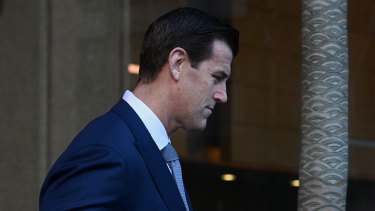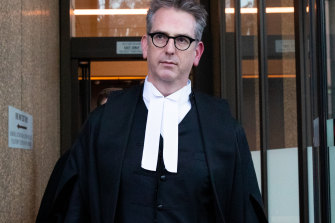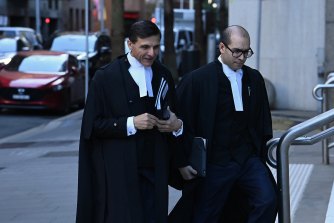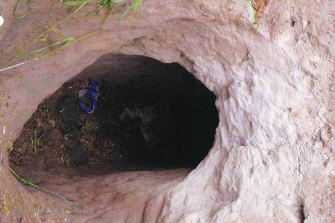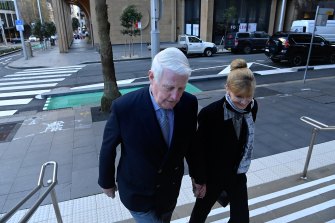As the Roberts-Smith case nears its end, barrister returns to where he began: ‘Someone is lying.’
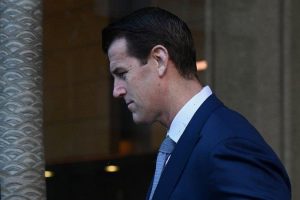
Closing the long arc of the Ben Roberts-Smith defamation case this week, Nicholas Owens, SC, barrister for Nine’s newspapers The Sydney Morning Herald and The Age, returned to the stark proposition he’d put at the beginning of hearings a year ago: that “someone is lying”.
So irreconcilable were the differences between the version of events put forward by Nine’s witnesses, and those of Roberts-Smith’s backers, they could not be explained away as “honest or innocent or otherwise unwitting differences in perception or recollection”, he said.
Indeed, Owens argued, not just one but multiple witnesses on the Roberts-Smith side had colluded, stitching up a false version of events to protect their friend, the once-storied war hero – a charge hotly denied by the soldier’s legal team.
Ben Roberts-Smith arrives at the Federal Court in Sydney on Monday.Credit:Kate Geraghty
If there seemed to be an air of deja vu about the proceedings this week, that was the point. This was the summing up, a last chance to press home the case for each side before the judge retires to consider the verdict, which may not come for many more months.
Owens held centre stage for much of the week, speaking – with barely a reference to notes – for hours each day, hands in constant motion as he methodically drew the threads of Nine’s case together, weaving back and forth across evidence elicited from more than 40 witnesses.
In the absence of a jury, this was about technical and forensic skill, not flights of oratory. The case in Sydney’s Federal Court will be determined by one man – presiding justice Anthony Besanko, who’s remained inscrutable throughout.
As ever, Roberts-Smith sat watching silently from the back of the court, with his parents once again in attendance.
Nine has set itself the task of proving the truth of its allegations. If Owens succeeds it will forever brand the Victoria Cross recipient a bully, a man capable of hitting a woman, and a murderer or facilitator of the murder of unarmed prisoners of war and therefore a war criminal.
Arthur Moses, SC, for Roberts-Smith, began an indignant counter-attack on Friday and will continue into next week seeking to demolish, piece by piece, Nine’s allegations.
The key contention of the soldier’s legal team remains that the media’s stories are the product of “years of character assassination by disgruntled members” of the SAS, who “fed” information to Nine’s investigative journalists Nick McKenzie and Chris Masters. The pair were not qualified war crimes investigators, Moses said. Nine instead carelessly portrayed Roberts-Smith as a “homicidal psychopath” through advancing a “fanciful and salacious case theory based on conjecture, speculation and imprecise testimony”.
Nicholas Owens, SC, spoke for hours each day this week with barely a reference to notes.Credit:Edwina Pickles
Nine originally laid six killings at the feet of Roberts-Smith. Owens conceded this week that one of those murders (said to have taken place near the village of Siah Chow) can no longer be made out, owing to Besanko’s decision not to compel a key witness – Person 66 – to testify, because the man believed he might incriminate himself.
Owens had previously maintained that proving the Siah Chow murder alone would have given him an “independent path home to victory”.
That leaves five other killings which Owens is resting the murder allegations on.
These include the much-publicised allegation that Roberts-Smith kicked an unarmed villager named Ali Jan off a cliff in the village of Darwan in September 2012 before conspiring with another soldier, Person 11, to kill the man and plant a radio device on him, falsely branding him a spotter for the Taliban.
Ben Roberts-Smith’s barristers, Arthur Moses, SC (left) and Phillip Sharp and outside the Federal Court on Monday.Credit:Kate Geraghty
Also given top billing by Owens are the events which took place at an Afghan compound designated Whiskey 108 on Easter Sunday 2009. There, the media outlets say, Roberts-Smith was responsible for the slaying of two unarmed Afghan prisoners, machine-gunning one himself and ordering the shooting of another. One of the prisoners possessed an artificial leg, which was later bizarrely re-purposed by the SAS as a drinking vessel.
The fourth and fifth killings are alleged to have taken place at the villages of Fasil and Chenatu (also known as Chenar Tu) in Afghanistan in late 2012.
Despite the gravity of the allegations, Owens says because it is a civil case he only has to prove that, on the balance of probabilities, the events occurred as Nine has described.
But Moses has warned “it will not be good enough for the media to point to the evidence and say ‘we nearly got there’.”
Among the strongest elements of Nine’s defence are the military witnesses its legal team produced in relation to several of the deaths, corroborating details from other soldiers who were nearby at the time. Moses has sought to depict two of these military witnesses as liars.
In relation to the Ali Jan killing, Nine’s legal team secured evidence from three Afghan villagers who testified by video link from Kabul, just days before the capital fell to the Taliban last year.
That testimony, given through an interpreter, was “littered” with detail that could only have come from people who were there on the day, Owens said. And key details were backed up by a soldier known as Person 4, and to a lesser extent, a second soldier known as person 56.
How was it, Owens asked, that Afghan villagers “on the other side of the world” could have provided detail that matched, in so many respects, what Nine’s military witnesses said took place? Moses claims this is because the villagers had been contacted by an intermediary for Nine before the case began.
Photo of the tunnel at Whiskey 108, tendered in Ben Roberts-Smith’s Federal Court defamation case.
Similarly, at Whiskey 108, Nine’s case relies heavily on alleged eyewitness testimony from fellow SAS members, including evidence from five different soldiers that a handful of Afghan prisoners were initially discovered hiding in a deep tunnel in one of the compound’s courtyards. Roberts-Smith and his backers have flatly denied that any Afghan males were found in the tunnel at all.
Owens put it to the judge that “if your Honour accepts … men [came] out of the tunnel, it follows almost inevitably that your Honour would disbelieve Mr Roberts-Smith’s entire case about Whiskey 108”.
Time and again, Owens made one overarching observation as he wove the threads of evidence together this week – that each of the military witnesses Roberts-Smith called were close friends.
Owens led the judge through an intricate timeline of clandestine meetings and communications between members of the group, sometimes using burner phones, which he said had so “impossibly contaminated” their evidence that they could not be relied upon as corroborators of each other’s stories.
Len and Sue Roberts-Smith, the parents of Ben Roberts-Smith, arrive at the NSW Supreme Court earlier this week.Credit:SMH
By contrast, Owens insisted, Nine’s witnesses were “honest” and “independent”, with no motivation to lie. Indeed, many of the soldiers called by Nine had been reluctant to give evidence at all.
In response, Moses says there was nothing improper in the fact that the soldier and his friends would seek to discuss the allegations being made against him.
Roberts-Smith had also repeatedly sought to suppress or hide evidence, Owens said, including through efforts to “suborn” three SAS members whom he suspected were briefing against him or were co-operating with a secret probe into war crimes allegations being conducted by the Inspector General of the defence force.
The former soldier enlisted a private investigator to (unwittingly) send anonymous threatening letters to two of those soldiers, and orchestrated an unjustified police raid on a third, Owens said. These were attempts at intimidation which provided “forceful presumptive indicators of a consciousness of guilt” on the part of Roberts-Smith.
Evidence to support Nine’s claim that Roberts-Smith had obsessively bullied a more junior trooper over many years was also laid out in forensic detail, as was the media outlets’ claim that he had assaulted his former mistress, known as Person 17, in a hotel room in Canberra during a clandestine extramarital affair.
Owens said attempts by the soldier’s legal team to undermine the woman’s credibility – on the basis that the way she acted after the alleged assault was inconsistent with her status as a “wealthy and intelligent” individual – were based on “thoroughly outmoded and outdated and discredited stereotypes”.
Owens and the two barristers assisting him, Lyndelle Barnett and Chris Mitchell, have given this final pitch their all. Should they fail, the damages Roberts-Smith will seek will likely run into the millions, on top of costs estimated at $25 million thus far.
Another of Roberts-Smith’s barristers, Matthew Richardson SC, asked the judge to remember that “this case is about a human being, a human being who has suffered, who was once known as a hero”. The question to be settled is whether through his deeds, Roberts-Smith brought that suffering on himself.
The Morning Edition newsletter is our guide to the day’s most important and interesting stories, analysis and insights. Sign up here.
Most Viewed in National
From our partners
Source: Read Full Article

